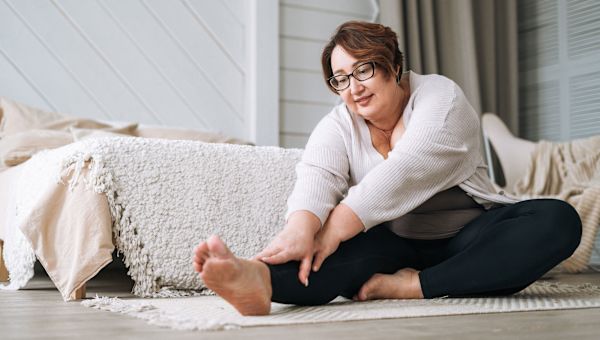7 Ways to Prepare for Joint Replacement Surgery
Planning ahead can help reduce your risk of complications and support your recovery.

Joint replacement surgery can help reduce your pain, increase your mobility and improve your overall quality of life. Like all surgical procedures, however, there are risks for infection and other complications. Joint replacement also involves a lengthy rehabilitation process. The good news is there are several things you can do in the weeks leading up to your operation that can reduce your surgical risks and help ensure a smooth recovery.
It’s important to be both mentally and physically prepared for joint replacement. But you may also need to make some adjustments to your routine and your surroundings, according to Cameron Ledford, MD, an orthopedic surgeon with Menorah Medical Center in Overland Park, Kansas. We spoke with Dr. Ledford about the best ways to prepare for your surgery. Here's what he had to say.

Get the details
You should be well-informed before surgery. That means you should try to learn as much as you can about your procedure, the potential risks involved and what you can expect during your recovery. Talk to your doctor about what will happen before, during and after your operation. Many people must remain in the hospital for one to three days following joint replacement surgery, Ledford points out. Don't hesitate to discuss your concerns.
Some questions you may want to ask your surgeon include:
- How will my procedure be performed?
- What type of anesthesia will be used?
- What are the possible complications associated with my surgery? What is my individual risk for these issues?
- Will any of my prescription medications or supplements affect my surgical risks?
- Should I adjust my medication regimen before surgery?
- How long should I expect to stay in the hospital?
- How long could my recovery take?
- When should I schedule follow-up appointments after surgery?
Before your operation, you may need medical clearance from a primary care physician or certain specialists, especially if you have other health issues. Ask your surgeon when you should schedule these appointments.

Slim down
Being overweight puts extra pressure on your joints. It can lead to complications and negatively affect the outcome of your procedure. Two of the main goals of joint replacement are increased mobility and long-term pain reduction. It’s important to understand, however, that obesity could actually prevent you from getting around more easily and improving your range of motion after surgery. It could also increase the odds that your joint implant or prosthesis will fail and require another surgery to repair or replace it.
Obesity also increases your risk for complications during and after surgery, including trouble receiving anesthesia, infection and blood clots. If you’re overweight, you’re also more likely to have other health issues that make surgery riskier, including type 2 diabetes, heart disease and obstructive sleep apnea.
Your doctor may recommend a weight loss plan to help improve your chances of a successful surgery. A healthy diet and regular exercise can help you achieve and maintain a healthy weight.

Get moving
Staying active before surgery can help with the speed and success of your recovery. Exercise can help build strength and improve joint flexibility, which could increase your range of motion and boost your endurance after surgery. Building upper body muscles can also help reduce fatigue when using a walker, cane or crutches after hip or knee surgery. "Staying fit, active and healthy is the best thing you can do to condition yourself prior to surgery," Ledford says.
Joint pain can make some exercises difficult, but Ledford points out that most people can increase their activity level in some way. "Everybody has the ability to do some form of exercise," he says. "Some may be able to continue low-impact physical fitness while others may be limited to the simple, repetitive exercises that can be performed in the comfort of one’s own home."
Start with walking, and if this or other exercises prove particularly painful, try lower impact activities, such as riding a stationary bicycle or swimming. Always ask your healthcare provider before starting a new exercise regimen. A physical therapist could also recommend specific exercises that are tailored to your needs and abilities, or warn you about activities that could do more harm than good during your recovery process.
Your surgeon may also recommend a pre-surgery physical therapy regimen, called prehabilitation. These exercises could help reduce your post-procedure pain.

Stop smoking
If you’re a smoker, the sooner you quit before your joint replacement surgery, the better. Although nicotine may numb some short-term discomfort, smoking can actually make your body more sensitive to pain. This can be particularly tough if you're living with chronic joint pain.
Smoking is also associated with an increased risk of post-surgery infection and other complications that make follow-up procedures necessary. In fact, the relative risk of reoperation for infectious complications was 80 percent higher among smokers than nonsmokers, according to a February 2017 study published in the Journal of Bone & Joint Surgery.
Smoking can also delay the healing process. Wounds need oxygen to heal, and exposure to cigarette smoke thickens blood and narrows blood vessels, which makes it harder for oxygen to travel throughout the body. Smoking also interferes with blood’s ability to carry oxygen. For the same reasons, smoking can also prevent bones from healing. This is known as nonunion, a condition that requires additional treatment.
Joint surgery patients should stop smoking at least one to two weeks before their procedure, although Ledford recommends cessation begin six weeks prior to surgery. Patients should remain smoke free after surgery. Gums, patches and prescription medicines are some additional strategies that could help you kick the habit for good.

Create a “safety zone” at home
After your joint replacement surgery, it will take time to rebuild your strength and regain your flexibility and mobility. During this recovery period, it’s very important to reduce your risk for falls, which could lead to injuries and damage your new joint implant. You may need to avoid stairs until you are stronger and more mobile. You may also have to rely on a cane, crutches or walker after surgery. You can practice using these walking aids before your operation.
It’s also a good idea to make some adjustments to your home that can help you get around more easily and safely, advises Ledford. "You want to remove any obstacles or potential fall hazards," he says. "Make sure you have easy access to the bathroom and places you can rest and elevate your legs."
Other steps you can take to prepare your home:
- Keep walkways clear of shoes, area rugs, wires and other objects.
- Move sleeping arrangements to a lower level of the house to avoid stairs.
- Place remote controls, phones, medications and other essentials in easily accessible locations.
Depending on your particular needs, your healthcare provider may also recommend installing grab bars in the bathroom, using a non-slip mat in the shower or elevating the toilet seat. In most cases, significant or costly measures aren’t required, Ledford notes. "Most people are fairly functional and independent just a few days after the surgery,” he says. “So, we wouldn't recommend high-cost or dramatic changes to the home.”

Stock up on essentials
Driving typically isn't recommended before your first post-op visit, especially if you're taking medication to manage pain. Your surgeon will let you know when it's safe to get behind the wheel again. In preparation of this, it’s a good idea to stock up on essentials, like nonperishable foods, medications, toiletries, paper goods and other supplies before your surgery, so you’ll have everything you need while you’re recovering at home.
A few days before your scheduled procedure, create a list of your necessities and gather these items. It may also be helpful to enlist the support of a friend or family member who can help you get what you might need and store these things in easy-to-reach places. You may also consider borrowing or buying helpful tools, such as a sponge on a long stick or device to make reaching far-away items easier.
Preparing and freezing food or stocking up on ready-made options can be helpful after surgery when you’re managing pain and may not be able to stand for extended periods of time.

Enlist some helpers
Even the most prepared surgical patients can benefit from the help of friends and family members. "Make sure you have a good network of people to aid you, certainly within the first two to three nights after surgery," Ledford says. "You just need somebody checking in on you to make sure your needs are met."
Keep in mind that you'll need a ride to the hospital on the day of your surgery and back home once you've been discharged. Make these arrangements well in advance so you’re not facing additional stress before the procedure. You'll also need someone to take you to follow-up appointments until your surgeon says it's safe for you to drive.
Immediately after surgery, there is a good chance you’ll need some help with everyday tasks, like maneuvering safely around your home. You’re encouraged to stay active by getting out of bed and walking to the kitchen and bathroom, but not without help. As a general rule, do not sit for longer than 30 to 45 minutes at a time.
Your helpers can also aid in taking care of your surgical wound, removing and replacing bandages and dressings as directed by your surgeon. They can also keep an eye out for signs of infection, like warmth and redness near the incisions, excess drainage and fever higher than 101 degrees Fahrenheit for 24 hours or more.
The prospect of joint replacement surgery and rehabilitation may be overwhelming; don’t be reluctant to ask for help from your family, friends or healthcare providers.
This content originally appeared on Sharecare.com.
More On


video

article

slideshow


video


video
